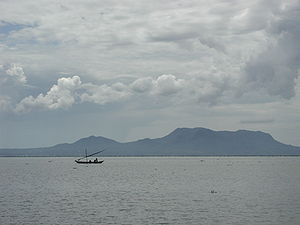
Mount Homa
Encyclopedia
Mount Homa is a mountain
located in western Kenya
. It forms a broad peninsula on the southern shore of Winam Gulf
, an extension of Lake Victoria
. This peninsula defines Homa Bay
and the mountaintop is about 20 kilometres north of the town of that name.
In the Luo language Got Uma or God Marahuma means "famous mountain".
The mountain is formed of carbonatite
lava and dates from Miocene
to Pleistocene
. Along with the active Ol Doinyo Lengai
, it is one of the very few carbonatite volcanoes in the world.

Mountain
Image:Himalaya_annotated.jpg|thumb|right|The Himalayan mountain range with Mount Everestrect 58 14 160 49 Chomo Lonzorect 200 28 335 52 Makalurect 378 24 566 45 Mount Everestrect 188 581 920 656 Tibetan Plateaurect 250 406 340 427 Rong River...
located in western Kenya
Kenya
Kenya , officially known as the Republic of Kenya, is a country in East Africa that lies on the equator, with the Indian Ocean to its south-east...
. It forms a broad peninsula on the southern shore of Winam Gulf
Winam Gulf
Winam Gulf is a significant extension of northeastern Lake Victoria into western Kenya.Formerly known as Kavirondo Gulf, Nyanza Gulf, and Lake Nyanza Gulf, it is a shallow inlet and is connected to the main lake by Rusinga Channel , which is partly masked from the main body of the lake by islands...
, an extension of Lake Victoria
Lake Victoria
Lake Victoria is one of the African Great Lakes. The lake was named for Queen Victoria of the United Kingdom, by John Hanning Speke, the first European to discover this lake....
. This peninsula defines Homa Bay
Homa Bay
Homa Bay is a bay and town on the south shore of Winam Gulf of Lake Victoria, in western Kenya. It lies near Mount Homa and Ruma National Park, the latter noted for Jackson's hartebeests and roan antelope .Homa Bay was once the District...
and the mountaintop is about 20 kilometres north of the town of that name.
In the Luo language Got Uma or God Marahuma means "famous mountain".
The mountain is formed of carbonatite
Carbonatite
Carbonatites are intrusive or extrusive igneous rocks defined by mineralogic composition consisting of greater than 50 percent carbonate minerals. Carbonatites may be confused with marble, and may require geochemical verification....
lava and dates from Miocene
Miocene
The Miocene is a geological epoch of the Neogene Period and extends from about . The Miocene was named by Sir Charles Lyell. Its name comes from the Greek words and and means "less recent" because it has 18% fewer modern sea invertebrates than the Pliocene. The Miocene follows the Oligocene...
to Pleistocene
Pleistocene
The Pleistocene is the epoch from 2,588,000 to 11,700 years BP that spans the world's recent period of repeated glaciations. The name pleistocene is derived from the Greek and ....
. Along with the active Ol Doinyo Lengai
Ol Doinyo Lengai
Ol Doinyo Lengai is an active volcano located in the north of Tanzania and is part of the volcanic system of the Great Rift Valley in Eastern Africa. It is located in the eastern Rift Valley, south of both Lake Natron and Kenya. It is unique among active volcanoes in that it produces...
, it is one of the very few carbonatite volcanoes in the world.


